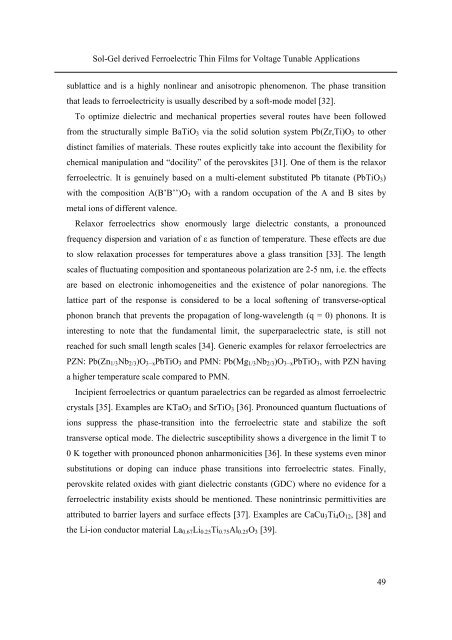PhD Thesis Arne Lüker final version V4 - Cranfield University
PhD Thesis Arne Lüker final version V4 - Cranfield University
PhD Thesis Arne Lüker final version V4 - Cranfield University
You also want an ePaper? Increase the reach of your titles
YUMPU automatically turns print PDFs into web optimized ePapers that Google loves.
Sol-Gel derived Ferroelectric Thin Films for Voltage Tunable Applications<br />
sublattice and is a highly nonlinear and anisotropic phenomenon. The phase transition<br />
that leads to ferroelectricity is usually described by a soft-mode model [32].<br />
To optimize dielectric and mechanical properties several routes have been followed<br />
from the structurally simple BaTiO3 via the solid solution system Pb(Zr,Ti)O3 to other<br />
distinct families of materials. These routes explicitly take into account the flexibility for<br />
chemical manipulation and “docility” of the perovskites [31]. One of them is the relaxor<br />
ferroelectric. It is genuinely based on a multi-element substituted Pb titanate (PbTiO3)<br />
with the composition A(B’B’’)O3 with a random occupation of the A and B sites by<br />
metal ions of different valence.<br />
Relaxor ferroelectrics show enormously large dielectric constants, a pronounced<br />
frequency dispersion and variation of ε as function of temperature. These effects are due<br />
to slow relaxation processes for temperatures above a glass transition [33]. The length<br />
scales of fluctuating composition and spontaneous polarization are 2-5 nm, i.e. the effects<br />
are based on electronic inhomogeneities and the existence of polar nanoregions. The<br />
lattice part of the response is considered to be a local softening of transverse-optical<br />
phonon branch that prevents the propagation of long-wavelength (q = 0) phonons. It is<br />
interesting to note that the fundamental limit, the superparaelectric state, is still not<br />
reached for such small length scales [34]. Generic examples for relaxor ferroelectrics are<br />
PZN: Pb(Zn1/3Nb2/3)O3−xPbTiO3 and PMN: Pb(Mg1/3Nb2/3)O3−xPbTiO3, with PZN having<br />
a higher temperature scale compared to PMN.<br />
Incipient ferroelectrics or quantum paraelectrics can be regarded as almost ferroelectric<br />
crystals [35]. Examples are KTaO3 and SrTiO3 [36]. Pronounced quantum fluctuations of<br />
ions suppress the phase-transition into the ferroelectric state and stabilize the soft<br />
transverse optical mode. The dielectric susceptibility shows a divergence in the limit T to<br />
0 K together with pronounced phonon anharmonicities [36]. In these systems even minor<br />
substitutions or doping can induce phase transitions into ferroelectric states. Finally,<br />
perovskite related oxides with giant dielectric constants (GDC) where no evidence for a<br />
ferroelectric instability exists should be mentioned. These nonintrinsic permittivities are<br />
attributed to barrier layers and surface effects [37]. Examples are CaCu3Ti4O12, [38] and<br />
the Li-ion conductor material La0.67Li0.25Ti0.75Al0.25O3 [39].<br />
49

















